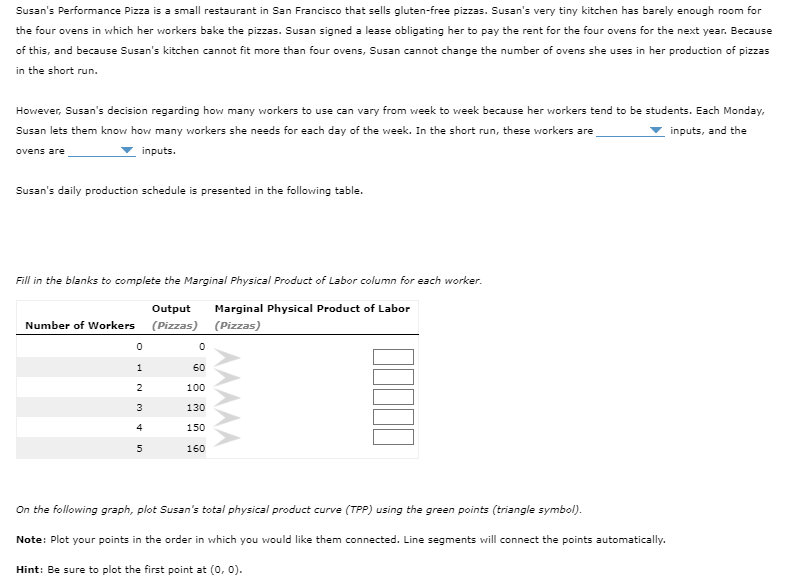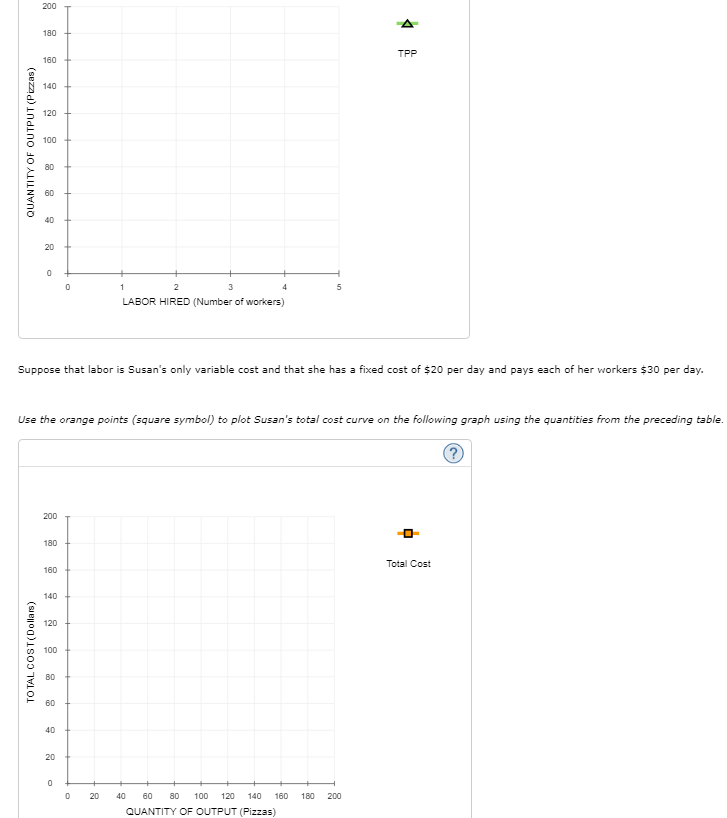Chapter1: Making Economics Decisions
Section: Chapter Questions
Problem 1QTC
Related questions
Question
True or False: The shape of the total physical product curve reflects the law of increasing marginal returns.
A.) True
B.) False

Transcribed Image Text:Susan's Performance Pizza is a small restaurant in San Francisco that sells gluten-free pizzas. Susan's very tiny kitchen has barely enough room for
the four ovens in which her workers bake the pizzas. Susan signed a lease obligating her to pay the rent for the four ovens for the next year. Because
of this, and because Susan's kitchen cannot fit more than four ovens, Susan cannot change the number of ovens she uses in her production of pizzas
in the short run.
However, Susan's decision regarding how many workers to use can vary from week to week because her workers tend to be students. Each Monday,
Susan lets them know how many workers she needs for each day of the week. In the short run, these workers are
inputs, and the
inputs.
ovens are
Susan's daily production schedule is presented in the following table.
Fill in the blanks to complete the Marginal Physical Product of Labor column for each worker.
Output
Marginal Physical Product of Labor
(Pizzas)
(Pizzas)
Number of Workers
0
1
2
3
4
5
0
60
100
130
150
160
On the following graph, plot Susan's total physical product curve (TPP) using the green points (triangle symbol).
Note: Plot your points in the order in which you would like them connected. Line segments will connect the points automatically.
Hint: Be sure to plot the first point at (0, 0).

Transcribed Image Text:QUANTITY OF OUTPUT (Pizzas)
200
180
TOTAL COST(Dollars)
160
140
120
100
80
60
40
20
0
200
180
Suppose that labor is Susan's only variable cost and that she has a fixed cost of $20 per day and pays each of her workers $30 per day.
160
Use the orange points (square symbol) to plot Susan's total cost curve on the following graph using the quantities from the preceding table.
140
120
100
80
60
40
0
20
0
1
2
LABOR HIRED (Number of workers)
3
0
4
20
TPP
40 60 80 100 120 140 160 180 200
QUANTITY OF OUTPUT (Pizzas)
-O-
Total Cost
?
Expert Solution
Step 1
The law of increasing marginal returns also called the law of diminishing costs states that as far as all the variables are kept constant, there will be extra efficiency i.e. the extra output that can be manufactured by adding extra labor or any other input. There would also be reduced marginal cost i.e. the extra cost incurred in producing one extra unit. The law of increasing and diminishing marginal returns is used by companies to know the optimum choice that would increase their efficiency.
Thanks for the questions. As you have posted multiple questions, as per guidelines we will answer the first question for you. Please post the second question separately.
Trending now
This is a popular solution!
Step by step
Solved in 2 steps

Knowledge Booster
Learn more about
Need a deep-dive on the concept behind this application? Look no further. Learn more about this topic, economics and related others by exploring similar questions and additional content below.Recommended textbooks for you


Principles of Economics (12th Edition)
Economics
ISBN:
9780134078779
Author:
Karl E. Case, Ray C. Fair, Sharon E. Oster
Publisher:
PEARSON

Engineering Economy (17th Edition)
Economics
ISBN:
9780134870069
Author:
William G. Sullivan, Elin M. Wicks, C. Patrick Koelling
Publisher:
PEARSON


Principles of Economics (12th Edition)
Economics
ISBN:
9780134078779
Author:
Karl E. Case, Ray C. Fair, Sharon E. Oster
Publisher:
PEARSON

Engineering Economy (17th Edition)
Economics
ISBN:
9780134870069
Author:
William G. Sullivan, Elin M. Wicks, C. Patrick Koelling
Publisher:
PEARSON

Principles of Economics (MindTap Course List)
Economics
ISBN:
9781305585126
Author:
N. Gregory Mankiw
Publisher:
Cengage Learning

Managerial Economics: A Problem Solving Approach
Economics
ISBN:
9781337106665
Author:
Luke M. Froeb, Brian T. McCann, Michael R. Ward, Mike Shor
Publisher:
Cengage Learning

Managerial Economics & Business Strategy (Mcgraw-…
Economics
ISBN:
9781259290619
Author:
Michael Baye, Jeff Prince
Publisher:
McGraw-Hill Education